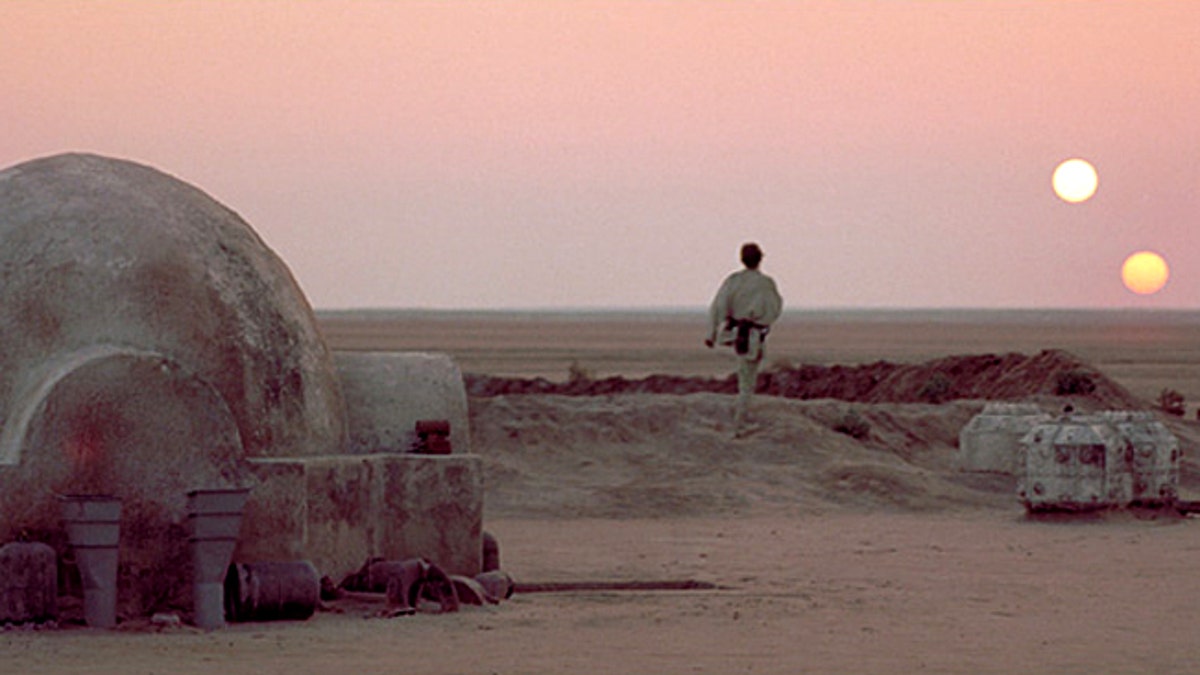
A young Luke Skywalker stares out over the dusty planet Tatooine in this film still from the movie, "Star Wars." (Lucasfilm)
A planet orbiting a dual star system is just like the dusty 'Star Wars' home world of Luke Skywalker, according to a research team from Carnegie Mellon. And while many planets have been suspected of having two suns, this newfound planet is the first “circumbinary" planet confirmed by astronomers.
“This is the first definitive case,” Alan Boss, one of the researchers who made the discovery, told FoxNews.com.
“People in the past have thought they saw instances like this. But there are other ways of explaining them. This is the first one where it’s absolutely, quantitatively sure that this is what the explanation is.”
The team has determined that the planet has a similar mass and density to Saturn, so they’ve concluded that their latest find is most likely a gas giant. And while Tatooine was a desert planet, this planet is most likely quite chilly, with temperatures about 100 degrees centigrade colder than on Earth. That’s about as cold as it gets in Antarctica during the winter.
But if it were possible to live on the planet, Boss says the sunsets and sunrises would be spectacular.
“It would change from day to day because the stars orbit around themselves every 41 days,” Boss told FoxNews.com. “So every time you look at them, they’re going to be in a different configuration in the sky. Sometimes they would be close together, sometimes they’ll be far apart. And when sunrises and sunsets occur, sometimes they’ll be quite widely spaced in time and sometimes they’ll go up and down almost simultaneously.”
The planet's discovery was an unintentional consequence of the prime mission of NASA’s spacecraft Kepler. Launched in 2009, Kepler’s goal has been to survey portions of the galaxy in search of Earth-sized planets orbiting stars like the one in our solar system.
The spacecraft examines over 150,000 thousand stars in the Milky Way, and every once in a while, some of them turn out to be "eclipsing binaries" -- two stars that orbit around a common center of mass. From Kepler's perspective, such systems have two eclipses: a primary eclipse when the larger star is partially blocked by the smaller one, and a secondary eclipse when the smaller star is fully covered up by the larger one.
Laurance Doyle, the lead author on the paper in Science, took a special interest in the eclipsing binaries to see if any of them showed a dimming pattern indicating a planet revolving around them.
“Laurance actually found the system where you can see the two stars eclipsing each other,” Boss told FoxNews.com. “And in addition you can find a third object which eclipses both of the stars periodically. First it dims one star, then it dims the other star. So you’re seeing four different types of dimming in the system which is unprecedented. No one’s ever seen that many types of dimming in a single system from just three objects."
"It was just a serendipitous discovery.”
The team immediately recalled the famous desert planet from Star Wars. They feel that this discovery is the closest proxy to date of any planet like Tatooine.
“Last year, there was a claimed discovery around a wide binary of a planet, and those press releases and stories also invoked the memory of Tatooine,” Boss told FoxNews.com. “But that was really inappropriate, because that was a wide binary system. Whereas Tatooine was about a system like this one, a close binary system where the two stars are right next to each other and the planets orbit around both of them.”
The Carnegie Melon team's findings will be published in Science on Sept. 16. They announced their discovery at a press conference at NASA’s Ames Research Center on Thursday, Sept. 15.
A representative from George Lucas’s visual effects company, Industrial Light and Magic, was in attendance, providing images of Tatooine and invoking the memory of Star Wars from so long ago.
“Star Wars started back in '75 or so, so it took 35 years for reality to catch up with science fiction,” Boss told FoxNews.com. “It’s wonderful. I wish they could figure out a way to have warp drive too. Wouldn’t we all like to go faster than the speed of light? It takes a little bit longer to solve that one I’m afraid.”
“But every once in a while, the science fiction guys get it right.”
